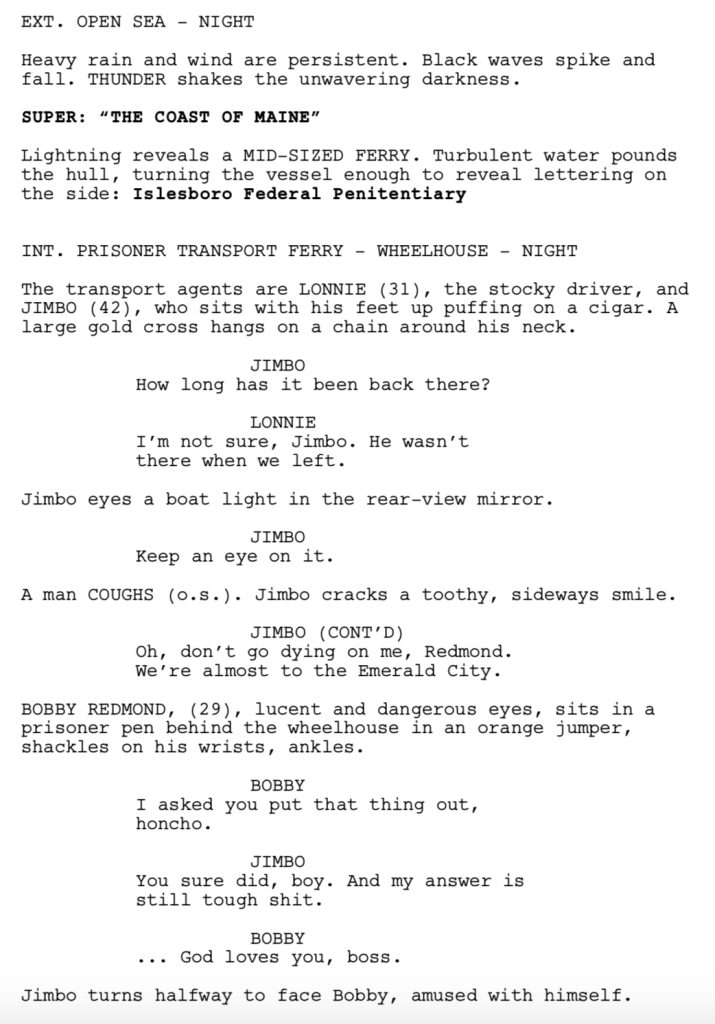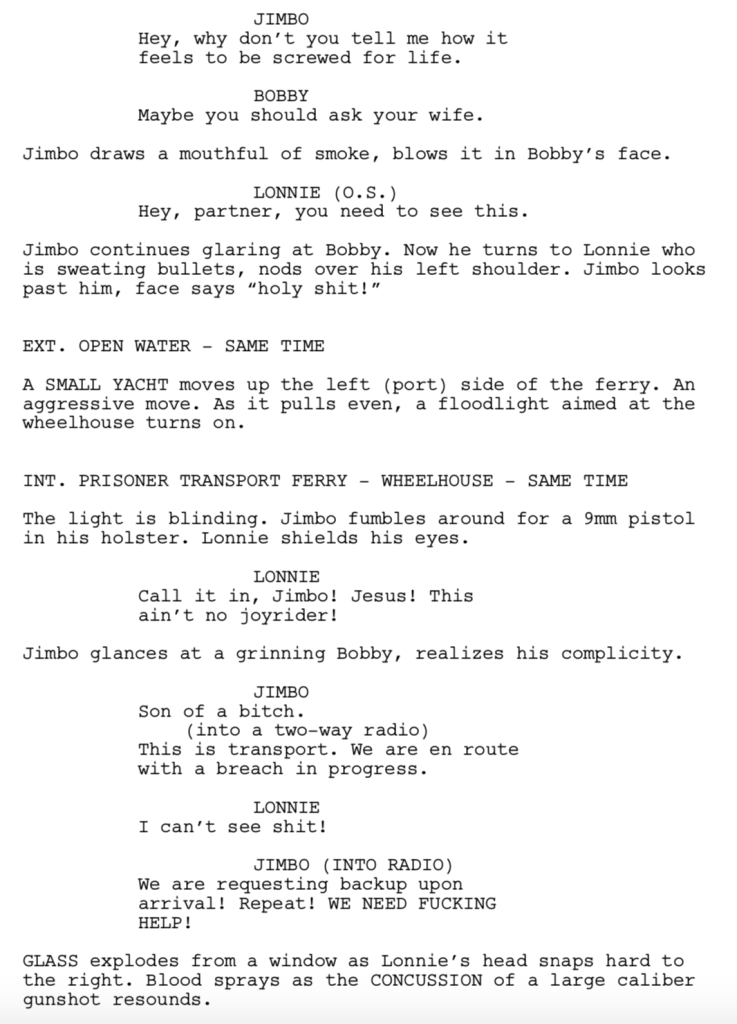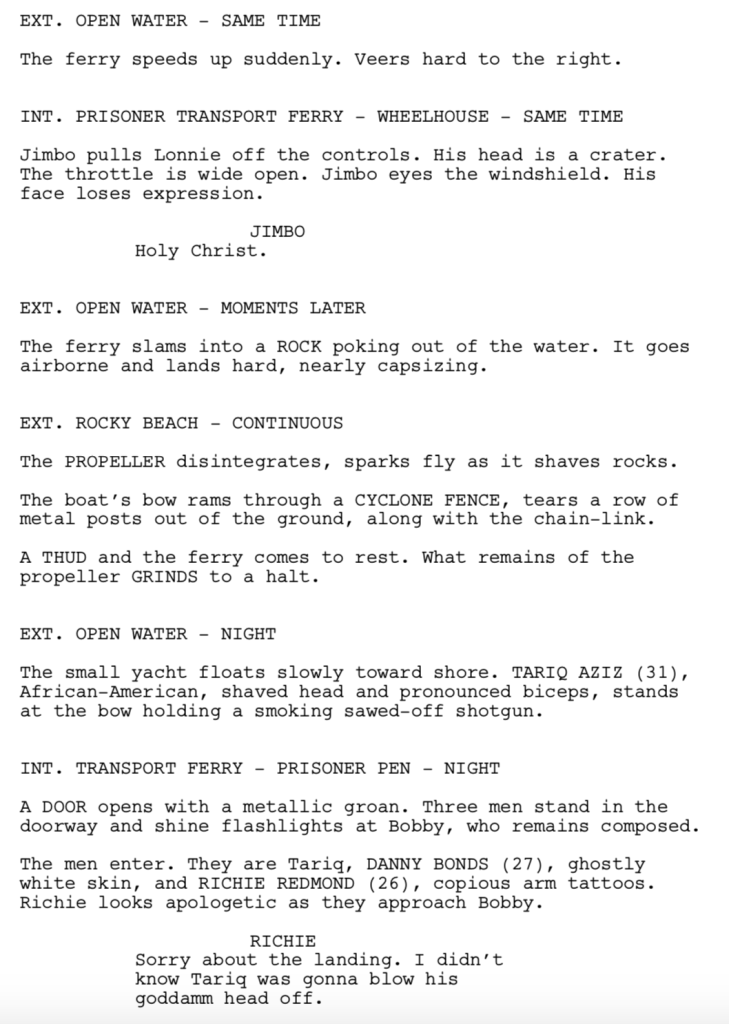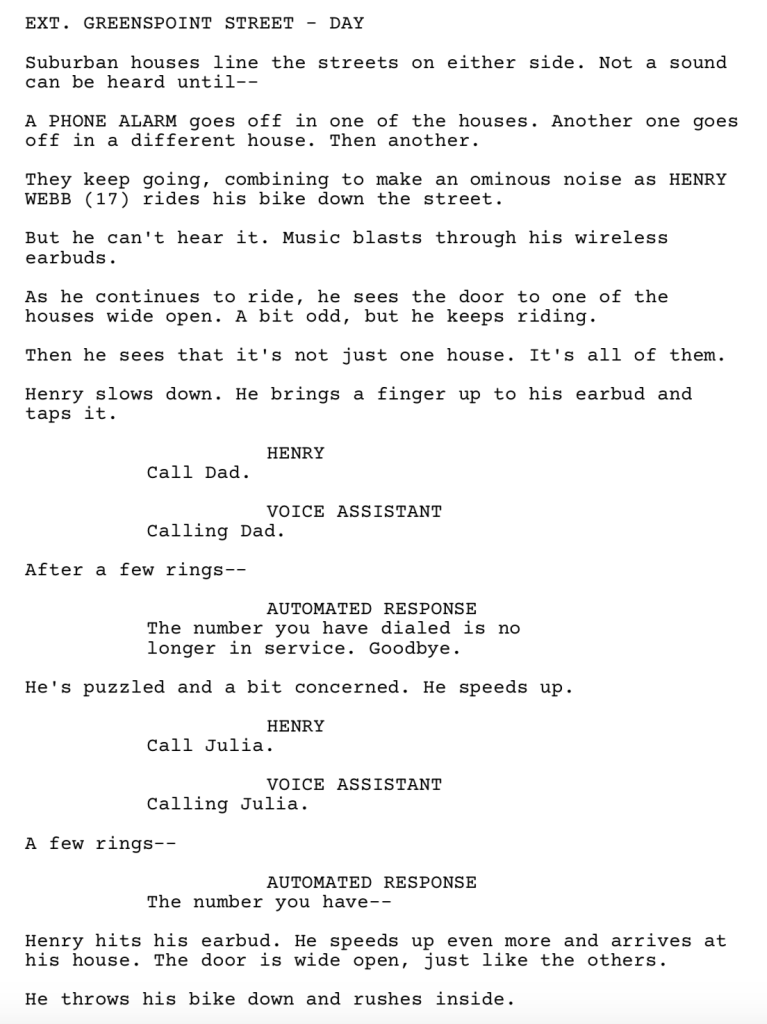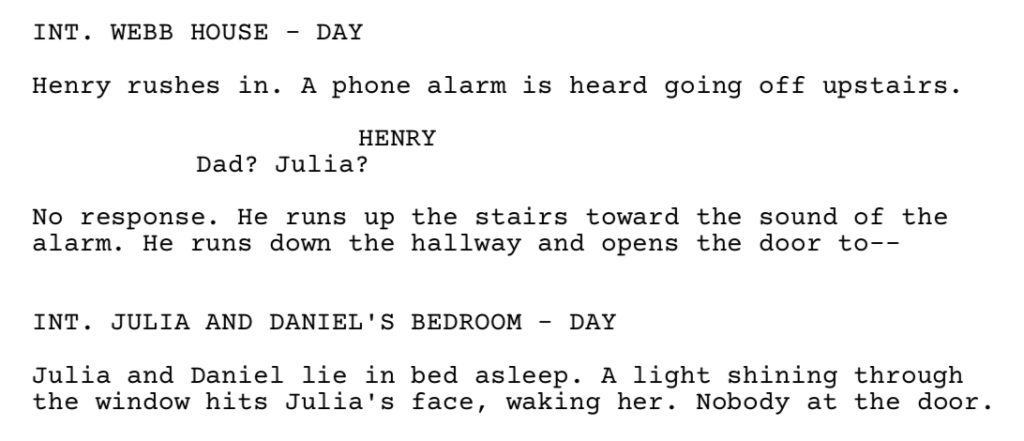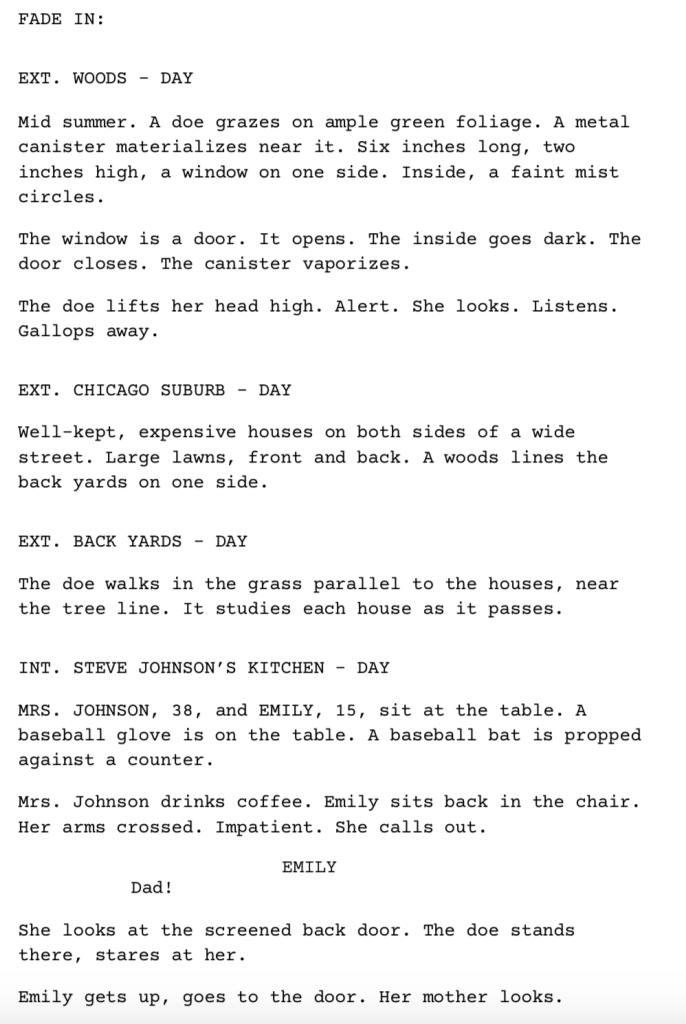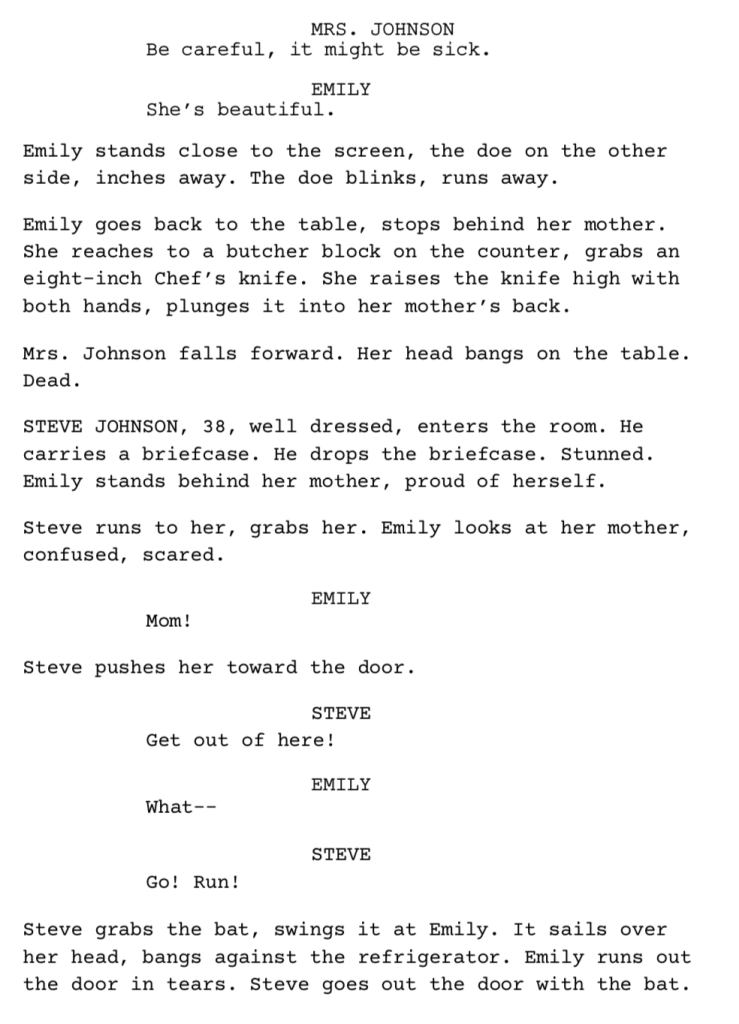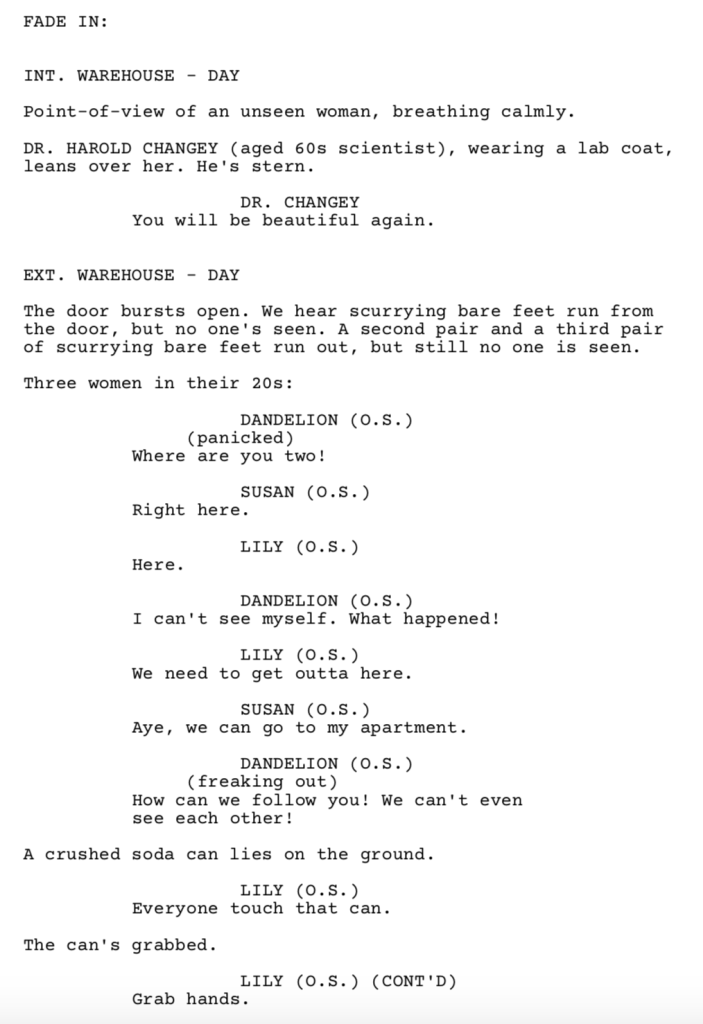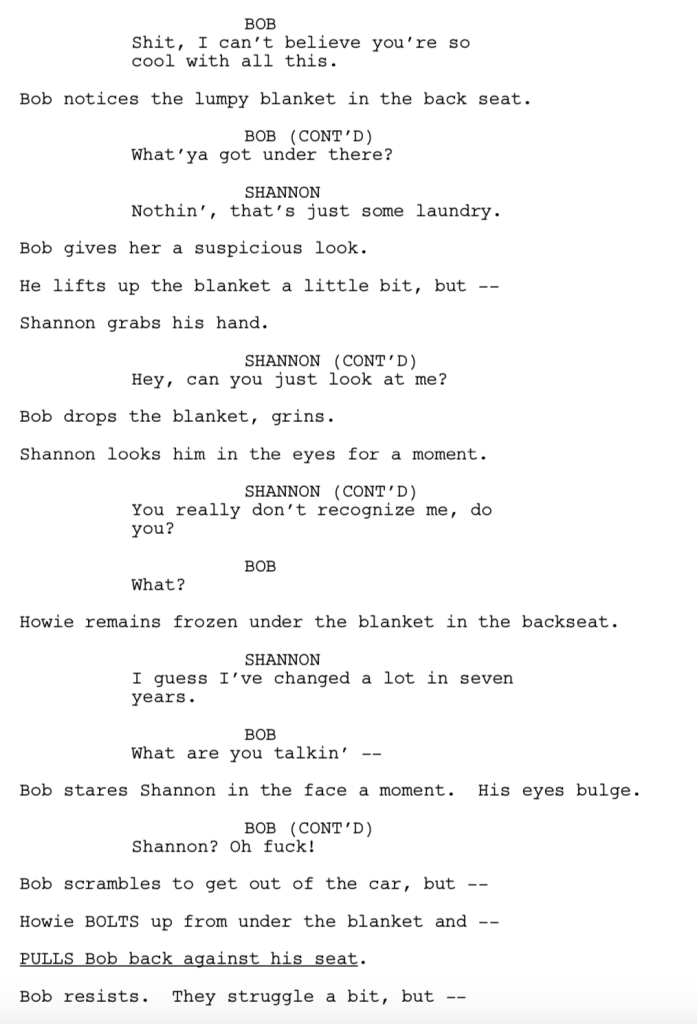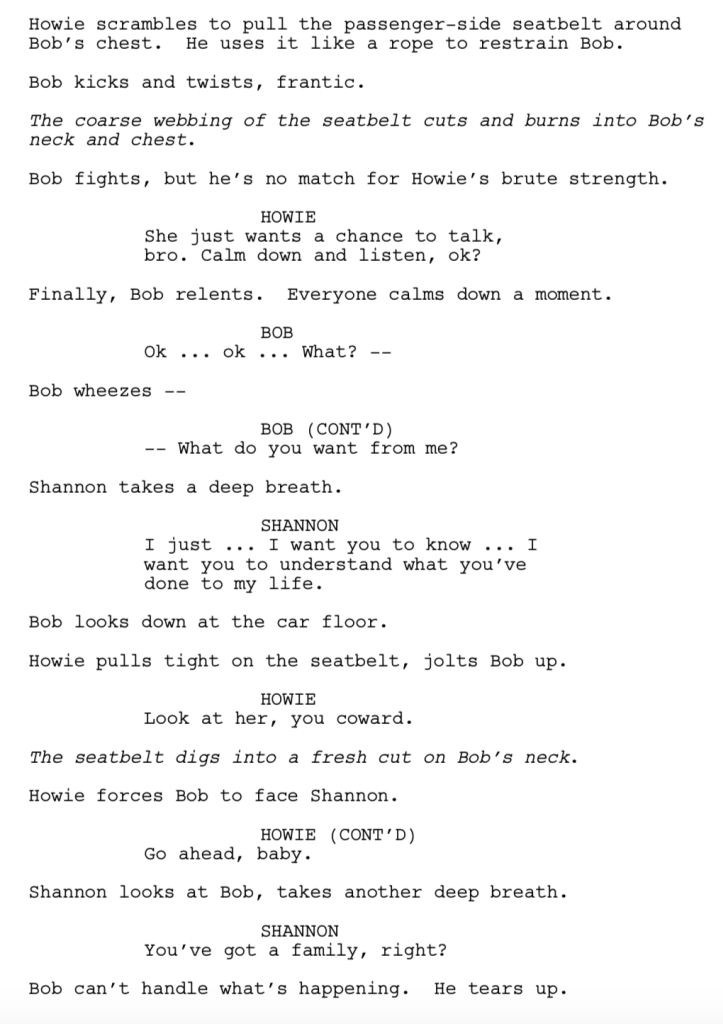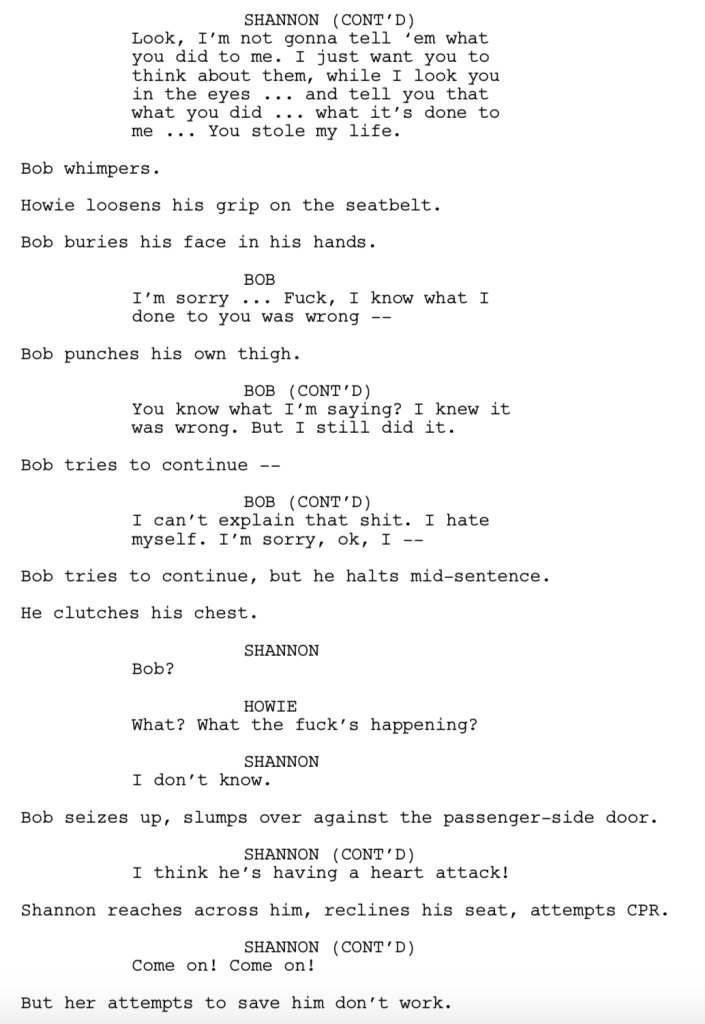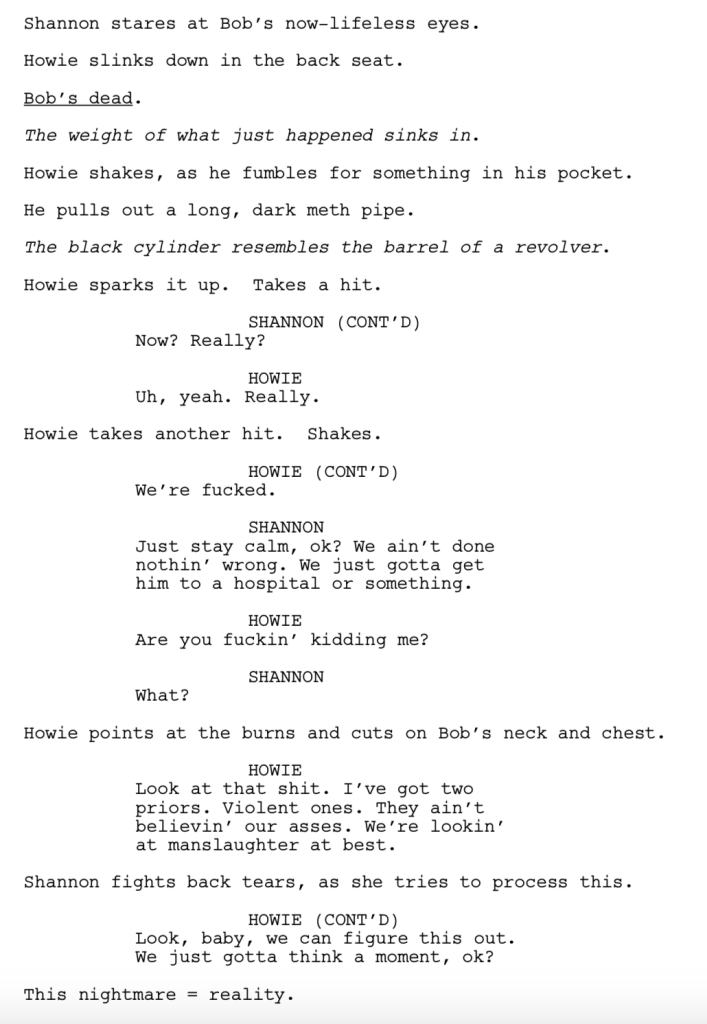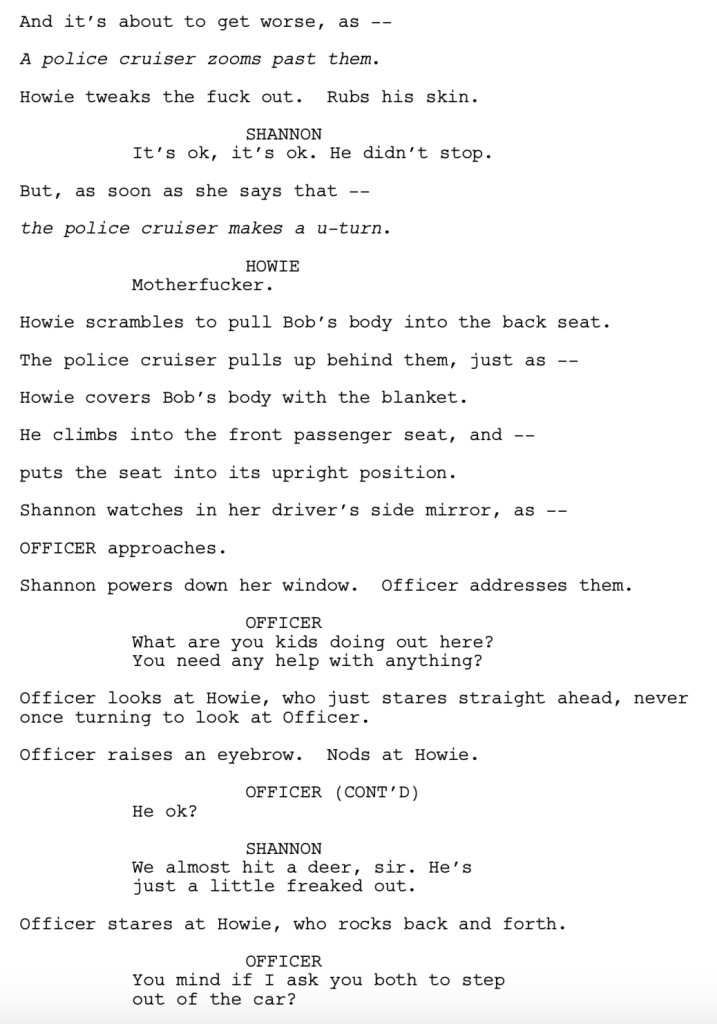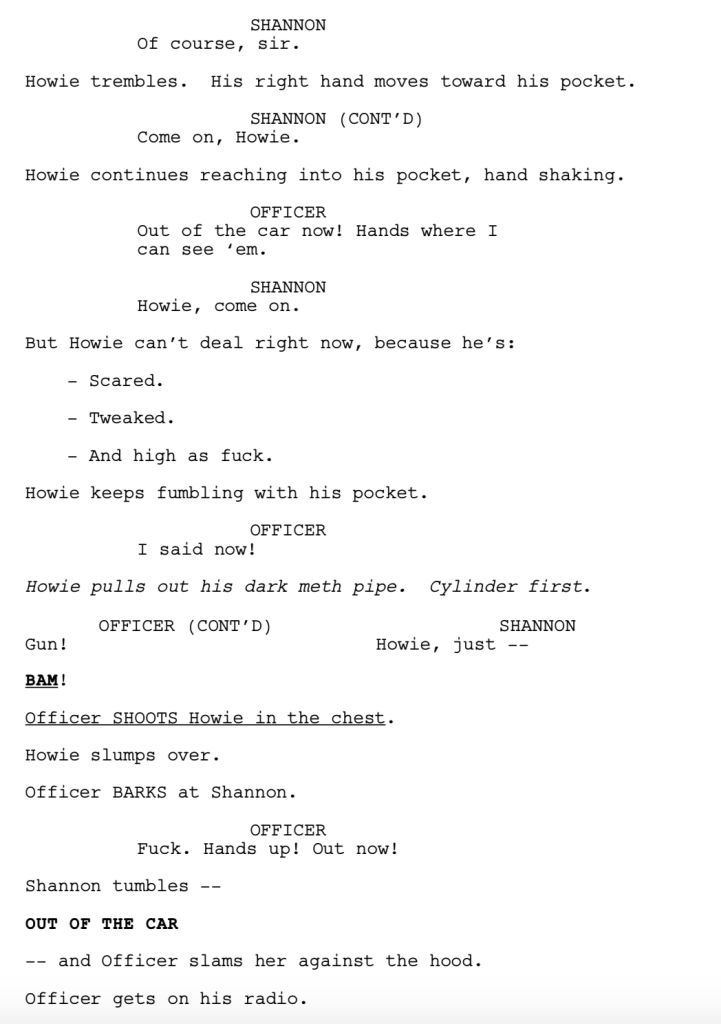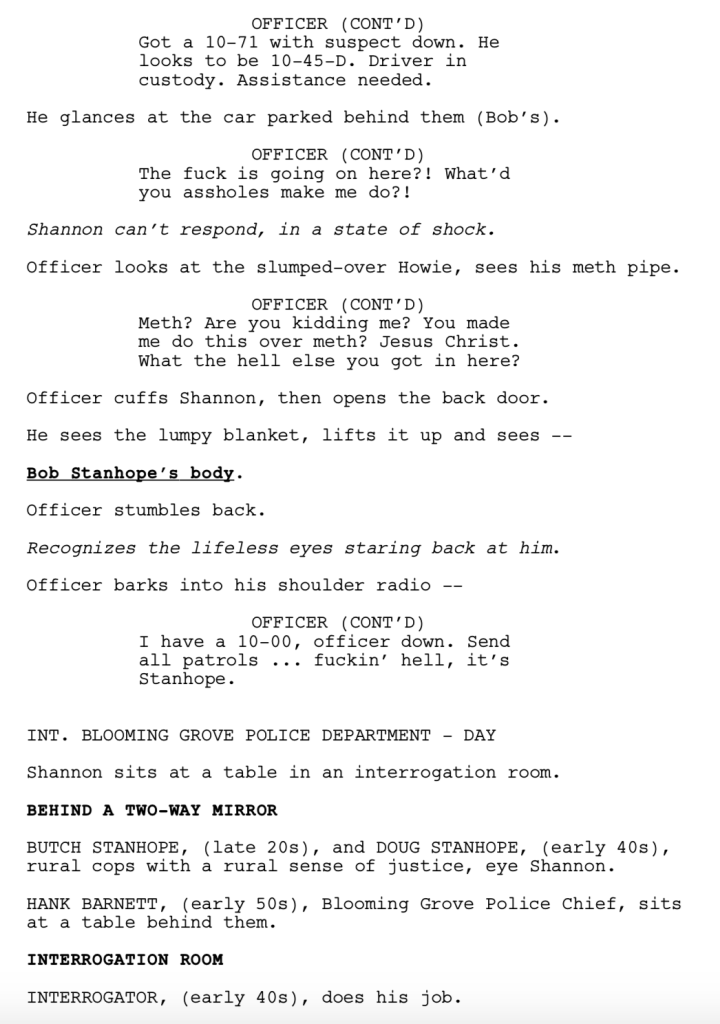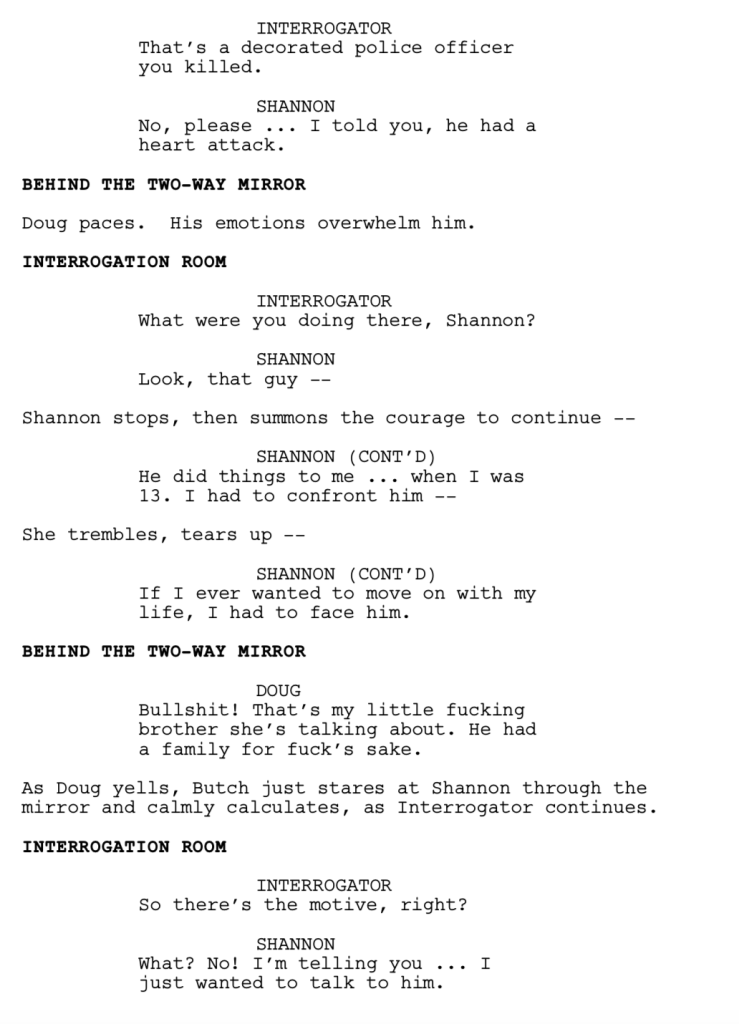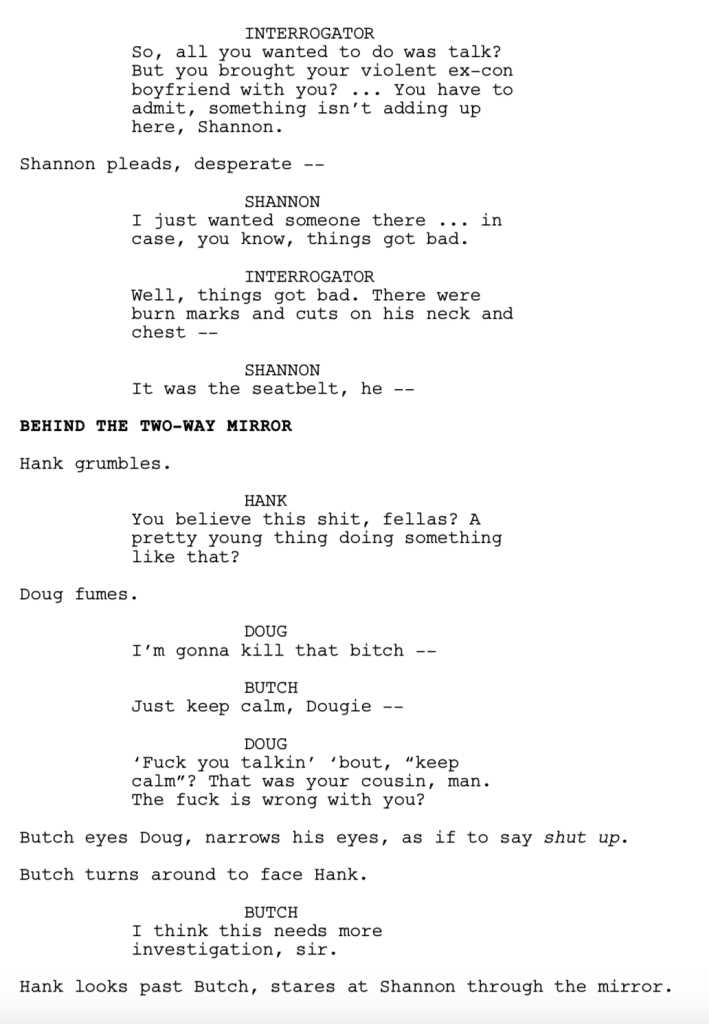It is Week 3 of the First 10 Pages Challenge! For those of you who don’t know what that is, the First 10 Pages Challenge is something I set up at the beginning of the year that asks you to write something unputdownable. You have until February 10th to enter your pages, which you can do at carsonreeves3@gmail.com. Every Thursday, I’ve been posting five entries and explaining why I stopped where I did. You can read last week’s entries here and the first week’s entries here. Today we’ve got five more.
Some of you have expressed surprise at how quickly I’ve given up on some of these entries. You went so far as to say, “I would’ve kept reading.” You know what my response to that is? Unless you contacted me or the writer and asked us for the rest of the script, you wouldn’t have kept reading. We’re not trying to write pages that someone keeps reading because they’re conveniently still in front of them. We’re trying to write pages that if you got to page 3 and the rest of the file was corrupt, you would immediately e-mail the writer and get them to send you the rest of the script because YOU NEEDED TO FIND OUT WHAT HAPPENED NEXT.
You might think this is extreme. That I’m asking the impossible. But seriously, do you think Hollywood is some cocoon of good vibes wrapped in hugs and encouragement? Where each screenplay is read with rapt attention and responded to with the promise of a future job if you just “keep trying hard?” This is one of the most competitive industries IN THE WORLD. Nobody cares about you. In fact, because writers are faceless, people in this business have no issues actively hating you. You are someone who can chew up 2 hours of their day with wandering drivel when they’ve got 10,000 more important things to do. Do you think, under those circumstances, that someone’s going to give your script their full attention because you’re trying hard? Because you have a pretty good first scene with a decent main character and wait til they get to page 45 because that’s when your screenplay really picks up? Be real.
You need to TEAR THESE PEOPLE OUT of their existence with your pages. You need to make them forget about all that other s*&% they’ve got to get done that day. A good writer with a great opening 10 pages can achieve that. But if you’re going to play this b.s. idealistic card where people give you the benefit of the doubt regardless of how you start your screenplay, think again. You need to hook the reader. That’s what this exercise is about.
Now let’s get to today’s entries.
This is one of the more interesting entries we’ve had on First Ten Pages Thursday because the writer’s doing a lot right. We have a couple of paragraphs setting up the scene. They’re not great but they end with an intriguing detail – that this is a federal penitentiary ferry. The reason this is important is because I’ve seen tons of scripts start inside federal penitentiary BUSES. But I’ve never heard of a federal penitentiary ferry before. Already we’re starting off with something unique, which is a good sign.
The writer doesn’t waste any time setting up an intriguing potential problem – that there’s another boat trailing them. This is a critical component to the scene because the writer has opened a line of suspense. We will now stick around at least until we find out what that other boat is about.
However, this is where the first slip occurs. The interplay between the characters is too basic. “Hey, why don’t you tell me how it feels to be screwed for life.” “Maybe you should ask your wife.” I’m not even sure that comeback makes sense. Just lost a little confidence in the script. Then, when the bad guys in the other boat do show up, the attack is really straight-forward. A guy gets shot, Jimbo tries to speed away. I literally went from Level 9 Interest to Level 3. And this was when the real life nature of this First 10 Pages Experiment reared its head. I didn’t even realize it but I had switched over to my browser to check my e-mail. I stopped not because I was thinking, “Should I or shouldn’t I keep reading?” My mind literally wandered to the point where I didn’t even realize that I had left the script.
Let me repeat: The goal of this exercise is to keep the reader’s interest for ten pages. If the reader is checking their e-mail, you’ve lost. And here, as harsh as it sounds, it was simply one predictable page that did the script in. The excitement of the opening was undermined by too basic of a reveal. Don’t take any lines off, guys.
This is a common reason why most readers give up on scripts. It’s not even a question of “Am I captivated or bored?” It’s that the events happening on the page don’t even make sense. There’s a line between mysterious and nonsensical and a lot of new writers don’t know where that line is.
A bunch of faceless phone alarms go off? Is that an intriguing opening story question? I’m not sure it is. Are these morning wake-up alarms? I’m assuming it’s morning but the sluglines say “DAY” and there’s no mention of morning anywhere. I’m going to make an educational guess and go with morning. But that begs a new question. Why is a 17 year old on his bike in the morning before everyone else is awake?
We highlight that a door to one of the houses is wide open and that that’s “a bit odd.” I’ve seen lots of open doors in my life and never once felt that it was odd. Henry then calls his dad and “Julia,” who I’ll assume is his step-mother. The “no longer in service” automated message provides a modicum of curiosity until one second later when Henry pulls up to his house where his dad and Julia live. If his house was one second away, why did he call his parents?
This writer needs to work on the sophistication of his delivery. You need to think about why characters are doing things and not just do them because you think it would make for a cool moment. You have to think of your characters as living breathing human beings who are governed by the same laws of logic and reason we are. Nobody calls their father to see if he’s home when you’re going to see that he’s home in 3 seconds.
Kudos to the writer for starting their script with something that grabs our attention. However, this is another case of weird shit happening without a lot of thought put into why or how it fits together. Before we get there, the first thing that stands out is the weird spacing on this document. I’ll say it again: people who are serious about screenwriting use professional screenwriting software. If I see a mistake as basic as weird spacing, that’s a red flag.
Next up, we have a six inch canister with a window. What do you mean a “window?” Does Ant-Man live in this canister? Literally within the first paragraph, we’ve got two red flags. The only reason I keep reading is because at least something’s happening. And I’m briefly vindicated when the daughter stabs her mom in something that promises a “Bird Box” like concept. However, the father’s response to this killing is so bizarre (“Leave!” – then throws a bat at her) that I know this is seconds away from falling off the rails. This feels like it was whipped together in ten minutes. Not going to cut it.
I can’t enjoy something if I don’t understand what’s happening. This doctor says he’s going to make someone beautiful. The next thing we know we’re looking at footsteps. So I guess somebody is invisible? How did we go from a movie about beauty to a movie about invisibility? Then this girl is joined by two other patients? Where did they come from? Are they using a group invisibility plastic surgery discount? — Some writers write without ever considering the reader. They’re so far in their head that they don’t realize what they’re writing doesn’t make sense. Put yourself in the mind of the reader. Does your scene play out in a clear and concise way when reading it from the other side?
Well lookie here. The first submission to get me to read all 10 pages! Congratulations to Bill Lawrence. Now in the spirit of full disclosure, I didn’t LOVE these pages. But the scene was constructed in such a way where it was hard for me to put the script down. Now here’s where things get interesting. You guys DIDN’T like these pages. This script was an Amateur Offerings entry two months ago and only received one (!!!) vote. I’ve tried to figure out why.
I suspect that people didn’t vote for it because the situation is too generic. It definitely moves. It has tension and conflict throughout. But it lacks any sense of originality. There is nothing new or fresh here.
I realize this is confusing. This is the first script to get you to read all 10 pages and you’re not over the moon about it, Carson??? Look, I’m a little confused myself. I’ll tell you this though. The writing was so sparse and easy to read, there wasn’t a reason to STOP reading. That’s the power of writing clear and concise prose. I think that if Bill kept this structure but added some elements that were more original or unexpected, I would’ve e-mailed him and said, “I need to read more of this.” For example, of course the man who sexually assaulted Shannon is fat and ugly. It’s cliche. What if he was an upstanding well-put-together pillar of the community instead? Stuff like that that’s not so on-the-nose. With that said, this is the only script that got me to read all 10 pages. So in this unofficial competition, it’s in the lead!
Genre: Action Thriller Sci-Fi Romantic Comedy
Premise: Barret is a social media influencer, the worst guy ever, and the eventual President of the United States. Dixie is a badass freedom fighter, sent back from 2076 to kill him before he takes over the world and ruins the future. They fucking hate each other. Then they accidentally fall in love.
About: This script finished Top 10 in last year’s Black List, a surprising showing considering the main character isn’t a real person (biopic joke). Michael Daldron seems to thrive in the absurd. He was a writer on the bonkers Dan Harmon TV show, Rick and Morty.
Writer: Michael Waldron
Details: 104 pages
We’re going to keep the absurdity alive this week! Yesterday, we covered a character who fell in love with a toe. Today, we explore traveling back in time to wipe out social media influencers.
What’s a social media influencer? I only found out the other day after watching Netflix’s Fyre Festival doc, a task I initially resisted because the media’s become a scourge of evil intent on destroying people’s lives regardless of whether they deserve it or not. I figured they did the same thing to this Fyre Festival dude. But ohhhh no. This guy deserved to be taken down. The crap he pulled would’ve caused a coma patient to stand up and demand action. I loved it so much I re-activated my dead Hulu account so I could watch their competing Fyre Festival documentary, which turned out to be even better than Netflix’s.
Anyway, all this is to say that social media influencers (the people who made Fyre Festival a “thing”) are vapid black holes of emptiness, the bottom rung of entertainment. And the current generation is growing up on them, which means they’re going to be the primary source of entertainment at some point. Get your Logan Paul merch while you can still afford it!
20-something Dixie lives in the year 2076, a post-apocalyptic future that is the result of a stupid douchebag of a social media influencer, The Duke, becoming president and ruining everything. After searching far and wide, Dixie locates a time-traveling backpack, and after killing the future version of Duke, goes back to the year 2018 to kill the young version of Duke so that he can never become president in the first place.
Dixie arrives in 2018 and immediately attacks the young Duke (who’s simply named “Barret” here). But within seconds of the attack, a 16 year old Duke disciple, Miller, also from the future, appears in a jet pack and attacks Dixie. Dixie and Miller battle while the confused Barret watches on, tweeting and instagram storying his fans about the attack.
Barret hops in a car and drives off, but Dixie easily catches up to him. When she finally has a clear shot to take him out, she waivers. This Barret may be a nimrod, but he’s far from the megalomaniacal super-douche that runs the country in 2076. After he pleads for his life, Dixie compromises and gives him a last dinner, which they share at Chuck E. Cheese. Unfortunately, the more Dixie talks to Barret, the more she kinda likes him. And by the end of the meal, she decides to postpone the assassination for a little longer.
The next day, Dixie comes up with another plan. If Barret walks back his earlier posts about running for president, he’ll never become president, and the future will be saved without Dixie having to kill him. But this comes with a new problem. If he does this, Dixie will disappear, since the future will completely change and she’ll have never been born. Since the two are starting to like each other, they postpone this ‘not running for president’ post a little longer.
The next thing you know, the two are living together, Dixie is pregnant, and Barret spends his downtime traveling back in time to World War 2 trolling Nazis. When Barret learns that Dixie already killed the future him before she jumped back in time, the two get in a fight and Dixie takes her time-travel backpack, jumps back 65 million years, and starts training velociraptors to talk. I could go on but does it really matter at this point? More time travel. More fighting. The two live happily ever after. The End.
I used to get mad at these scripts – when the comedy is so absurd it takes precedence over plot and character. But now I realize different people think different stuff is funny and while I may not have liked it, younger audiences who don’t put a premium on logic and plot progression will probably enjoy it for the same reasons I didn’t.
I do think a world where Logan Paul is president is a funny setup. My issue is that these types of setups are great for a 22 minute episode of Rick and Morty, but become tiring stretched out to two hours. And you can see that play out as you’re reading the script. Once Dixie and Barret enter into a relationship (about 50 pages in), it’s clear the writer doesn’t know where to go. So he goes everywhere. I mean at one point we’re 65 million years in the past listening to a deep conversation between Dixie and velociraptor.
At times, Waldron’s script almost becomes the thing he’s making fun of. Here we are blasting narcissistic millennials obsessed with Instagram stories yet half the script is written in CAPS while being self-referential and breaking the fourth wall (for example, when a fight occurs, we’re told that it will get nominated for an MTV Movie Award for Best Fight). If that isn’t the screenplay equivalent of a douchey influencer posting an Instagram story, I don’t know what is.
I also think there’s a bigger discussion here about writing a script that’s trying to be fun and writing a script that IS fun. When you’re having fun, it comes off on the page. But when you’re TRYING to write that viral fourth-wall breaking screenplay, it can come off as try-hard and your script quickly goes from cool to lame. Deadpool constantly walks this line and one can make the argument the sequel crossed it. You could feel it desperately trying to make you laugh, instead of trusting its story so that the laughs came naturally.
The one thing I’ll give this script is that, just like yesterday’s screenplay, I didn’t know where it was going. I was dreading a 105 page wall-to-wall comedy action flick where Dixie tried to kill Barret the whole time. That’s what most writers would’ve done. One of the most boring things you can do is to hit the same beat over and over again in a screenplay. You have to come up with clever ways to spin the story in different directions so the plot stays fresh. And Waldron achieved that. I was surprised when these two got together. And I didn’t know where their relationship was going to go from there. I think it says a lot about how much readers value unexpected plotlines that both this and The Toe finished highly on the two big End of the Year lists.
In the end, however, this isn’t my thing. I can throw all the screenwriting gobbledygook at you I want to explain why I didn’t like it. The truth is that when we don’t like something, we can come up with a million reasons why. This script was too juvenile for me. But it’s probably just the right flavor of juvenile for someone else.
[ ] What the hell did I just read?
[x] wasn’t for me
[ ] worth the read
[ ] impressive
[ ] genius
What I learned: Remember that the more words and sentences you cap in a screenplay, the less impact those words have. They become just as normal as uncapped words. Understanding, then, that the point of capping something is to bring to attention to it, use it sparingly, so that you can actually draw attention to the action you want to draw attention to.
Today I encountered something I never thought in a million years I’d read… the female Fight Club.
Genre: Thriller
Premise: (from Hit List) On the night of her 30th birthday, Elizabeth accidentally comes into possession of a very special item…a severed toe. She soon finds herself obsessing over the toe’s owner and, desperate to shake up her own mundane life, must decide whether or not to give in to the darker impulses the toe has stirred within her.
About: Mallory Westfall was nominated for Tisch’s (USC) Oliver Stone Screenwriting Award with her script, Begotten. She has since been a staff wrier on Syfy’s horror series, Channel Zero. She currently works as an executive story editor on AMC’s Fear The Walking Dead.
Writer: Mallory Westfall
Details: 128 pages
Man, for all you Scriptshadow readers yet to graduate high school, I highly recommend going to NYU’s Tisch or USC’s School of Cinematic Arts. I’ve seen a TON of Hit List and Black List writers who attended one of those two schools.
A lot of people ask me if it’s worth going to college for film or screenwriting. If you can get into Tisch or USC, hell yeah. Not only do you get screenwriting teachers who’ve actually worked in the business. But if you can get into one of these schools and network your ass off, meeting and befriending as many people as possible, you will work in this business, one way or another, for the rest of your life.
The irony of today’s script is that it’s nothing like the stuff that usually comes out of these schools. While there is some level of structure present, it’s hardly what you’d call a tight script. For the first half of the screenplay, I had no idea where it was going. Every time I thought, “Oh, it’s THAT kind of movie,” it would change into something else. After awhile, I got frustrated. “What is this???” And then I figured it out. I was reading the female Fight Club.
Elizabeth is turning 30 tomorrow, which sucks because her life’s lame. Turning 30’s fine when everything’s on the upswing. But when you’re stuck in a dead end office job and everyone around you can barely remember your name, it’s no fun.
One day after work, Elizabeth is driving home, and the back door of the truck in front of her bursts open, giving her a view of an entire group of people tied up. One woman in particular, with purple toe nails and a moose tattoo on her leg, locks eyes with Elizabeth. Quickly, a man inside the truck slams the door closed, but not before something flies out of the truck and slams into her windshield. It’s a toe! A toe with purple nail polish!
Elizabeth takes the toe home and begins to worship it. Strangely, it begins to bring her confidence. She starts standing up for herself at work, even swearing in front of her co-workers! Elizabeth becomes obsessed with the toe’s owner, and begins investigating who she might be. This leads her to a mysterious bus stop (which happens to be right across the street from her apartment) where she’s picked up and taken to a warehouse. There she’s terrorized by men in masks who threaten to kill her.
Just when it looks like it’s over, Elizabeth is told that this place isn’t some twisted hellhole, but actually a company where people pay to have the shit scared out of them. The idea is to be “woken up,” jolt your mind so that you start appreciating life again. Invigorated, Elizabeth continues her hunt to find the mysterious, now toe-less, girl. Eventually she meets her at a party for people who have been through the company torture experience, and befriends her.
Keesiah loved her experience with the company but didn’t think they went far enough. So she recruits Elizabeth to give people an even more life-rattling experience, with one twist: They don’t sign up for it. Elizabeth is so obsessed with Keesiah at this point that she goes along with it. But she soon realizes that Keesiah is not mentally sound. And that if she doesn’t do something to stop her, Keesiah will end up killing someone.
I’m torn over this script. On the one hand, it’s weird as hell. On the other, we need more weird scripts like this. This is exactly what’s been missing from The Black List. These used to be on the Black List all the time. But with everyone writing biopics these days (it’s only a matter of time before someone writes a biopic about the person who invented the biopic), there aren’t as many slots for offbeat material like The Toe. So while I have problems with The Toe, I’m happy Westfall wrote it.
The first problem I have is that this script is waaaaaaaaay too long. 130 pages? For a script about a severed toe? Come on. That’s the screenwriting equivalent of a hostage situation. And you don’t have to be Stephen Hawking to figure out why the page count is so high. It takes Westfall 10 pages to establish that Elizabeth is introverted and friendless. Established screenwriters can achieve that in 3 pages with their eyes closed. All you need is one quick scene at the office where it’s clear nobody hangs out with Elizabeth and you’re done.
Whenever I see slow opening pages, I know I’m in for a long read. The opening pages should move the fastest, not the slowest. Get us into the story as soon as you can. After that, the script sort of wanders into this strange romantic relationship between Elizabeth and her toe. This section was also slow. The same beats – Elizabeth needing to be around the toe – were repeated over and over again. Good lord. Screenwriting Rule 8a: Don’t repeat the same beats!
Yet strangely, I wanted to keep reading. The main reason being I had no idea where this was going. Was Elizabeth going to enter into a relationship with the toe, like that movie Lars and the Real Girl? Then later, when she was kidnapped, were they going to kill her? Then later, when she realized it was a company, was she going to expose them? Join them?
It was enough to get me to the point where Keesiah entered the picture. And that’s where the story officially picked up. Once you have a psycho in your script, people are going to keep reading if only to see what that psycho is capable of. It’s no different from Tyler Durden in Fight Club. What was this guy up to? What was he going to do next? A major reason for that movie’s success was the curiosity surrounding that character.
Still, The Toe could’ve been so much tighter. We literally don’t meet Keesiah until page 68. PAGE 68! That’s nuts. We should’ve met her by page 45. Page 55 at the latest (midpoint of a 110 page script, which is what this should’ve been). What happens when you introduce a main character that late is you have to cram their storyline into a much tighter space. If you meet her early, you have time to build up her character, lay out her story, give the character the time they deserve. When does Tyler Durden arrive in Fight Club? By the end of the first act, right?
Then again, there are no rules in this business. If you want to linger, you can linger. If you want to introduce characters late, you can introduce characters late. An argument can be made that that’s why this script was so interesting. The late-arriving plot points kept you wondering where all of it was going. I’m just not convinced that was the plan. I suspect it might have happened by accident.
Still, this was weirdly entertaining. I give it to Westfall for trying something different.
[ ] What the hell did I just read?
[ ] wasn’t for me
[x] worth the read
[ ] impressive
[ ] genius
What I learned: One of the laziest devices you can use to get your hero out of a complicated situation is to have them hit their head and pass out then cut to later. Late in the script, when Keesiah is making Elizabeth help her sever the fingers of one of their victims, Elizabeth tries to stop her, the two scuffle, and Elizabeth falls, bumps her head, and passes out. This allows the writer to cut to later, with Elizabeth waking up and asking Keesiah what they did. Please writers, STOP DOING THIS! I have lived an entire life without ever seeing someone fall down, hit their head, and pass out. Yet if you read the screenplays I read, you’d think it was a daily occurrence in every single person’s life. If you ever make your character hit their head and pass out, ask yourself if it’s an organic action that makes sense for the story or if you’re just being lazy. If it’s the latter, go back and rewrite it.
Genre: Dramedy
Premise: After receiving the news that her show is being canceled, a prickly female talk show host goes back into the writer’s room for the first time in years, where she finds inspiration from a young female comic who’s just joined the staff.
About: Sundance! Which means lots of movie sales. This film just debuted at the festival, fetching one of the biggest sales ever – Amazon bought it for $13 million dollars. I confess that I’ve never understood what these sale prices mean. The movie itself probably costs $13 million to make. So does that mean they’ve simply broken even? Cause I’m assuming once Amazon buys it, they take all the profits. Who knows. Anyway, the movie stars Mindy Kaling and Emma Thompson. It will likely be marketed similarly to Amazon’s The Big Sick. The script originally appeared on the 2016 Black List.
Writer: Mindy Kaling
Details: 131 pages! Yikes!
The fact that I liked today’s script says a lot. Because I don’t like Mindy Kaling’s comedy. In fact, to demonstrate how little I like her comedy, I’ve been watching old Office reruns on Netflix and every time she comes on, I fast-forward, even though it takes more time to go through the process of fast-forwarding than had I just let her say her joke. It goes to show that if you write something good, you can overcome anyone’s bias. Cause my bias was strong on this one. Strong like bear.
Ice Queen British import Katherine Newbury is a staple of late night American talk shows. At one point, she was the best in the business. However, things have gone astray. Katherine is so on auto-pilot that she doesn’t even know the names of her writing staff. In fact, when she comes down to talk to the staff in one of the script’s early scenes, she asks where John is. “John died in 2012” someone informs her. Yeah, it’s that bad.
Meanwhile, 30-something Molly Chaterjee is attempting to move out of her boring chemical managerial job into comedy. It just so happens that Katherine is trying to spice up her all-male writing staff and so informs her producer to hire a woman. Molly lucks out in that she’s the first interview and gets hired basically because the producer is too lazy to interview anyone else.
As this is happening, Katherine gets word from corporate that this will be her last year on the show. Her ratings have been in decline for awhile now. But, more importantly, her heart hasn’t been in it. All of a sudden, Katherine realizes how much she needs this job and sets out on a course to win it back at all costs. She does this by doing unheard of things such as being present in the writer’s room. This is where she runs into Molly, who clearly has no business being here. She has no experience and no understanding of how even the most basic aspects of joke-writing work.
However, Katherine soon realizes that her all male staff is pitching the same jokes that they’ve always pitched, which are the same jokes that the all-male staffs from all the other late night shows pitch to their bosses. Molly, meanwhile, is encouraging Katherine to start talking about her personal life. When she talks about things she cares about, she shines. Katherine listens, gives the advice a shot, and, all of a sudden, her show becomes hot again.
Unfortunately, just when it seems like her career is saved, one of Katherine’s adversaries leaks something to the press that’s been rumored forever. Katherine has spent the last two decades sleeping around, cheating on her husband. Realizing she’s toast, Katherine prepares to hang it up. That is until Molly challenges Katherine to address the scandal in a monologue. If she’s open, honest, and finally lets her guard down, she just might be able to save her career, and the show.
I have a theory about this script. I think Katherine was originally a male character. It seems unlikely that you would conceive of an older female British talk show host in the U.S. We don’t have any precedent for that here. And this was obviously inspired by the David Letterman cheating scandal. So I believe the character was originally a man and, at some point, Kaling changed it to a woman.
I don’t know why she did this. But it was a critical change. It turned what would’ve been an okay story into something great. Just the scandal element alone is more complicated when the character is a woman as opposed to a man. It was such a successful choice, in fact, it should act as a reminder to writers to always challenge their original conceptions of a character. Not just whether they’re a man or a woman. It could be gay or straight. It could be aggressive or passive. It could be fun or serious. That one change could be the thing that ignites the character and turns them into something special. And there’s a reason for that. Our minds think logically. We set characters up the way they’ve always been set up. A late night male talk show host. Of course. That’s how they all are. It’s only when you go against the norm that the character becomes unique.
Moving on with the rest of the script, Kaling is attempting to do something tricky here, which is to craft a two-hander. There isn’t one protagonist in this movie. There are two. And despite how easy she makes it look, I warn writers to tread these waters carefully. Everything about the structure of your screenplay becomes more complicated when you go the two-headed protagonist route. For example, the inciting incident of this script happens on page 30. That’s when Katherine is told she’s losing the show. Why does it come on page 30 instead of page 15, where it traditionally shows up? Because Kaling has to set up two main characters instead of one. So it takes twice as long.
Now Kaling is a good enough writer where we don’t feel that extra time. But most amateur writers don’t yet have the skills to keep us invested for that long before a major plot point shows up. Kaling starts us with with a strong opening scene where an underdog female comic does standup for a tough crowd. The suspense and build-up to her routine was perfectly executed. We wanted to stick around to see how she was going to do. If you’re good at writing suspenseful scenes and setting up characters in compelling ways, then maybe you can pull this off. But I’d still recommend nailing a single-protagonist screenplay first. That’s hard enough.
This is a good one, guys. If you’re struggling with character, I would read this script pronto. It’s very character-driven. We’ve got characters with flaws (Katherine refuses to open up), with backstory (Molly comes from an unexpected background), and, most importantly, the characters are trying to figure themselves out. It’s not just about getting to the next plot point. It’s about battling inner obstacles that keep us from being what we want to be. When you explore humanity that honestly, your screenplay will rise above the typical fare that dominates this town. Very impressed with this.
[ ] What the hell did I just read?
[ ] wasn’t for me
[ ] worth the read
[x] impressive
[ ] genius
What I learned: Plot Points vs. Character Points. Screenwriters are often slaves to their plot. All they care about is getting to the next plot point. “I have to get to the part where they fire her! That’s what keeps the plot moving.” This is a good mentality to have. But don’t forget to add character points as well. A character point is something that happens to your character that isn’t necessarily tied to the plot, but it adds depth to both your character and the story. For example, after Katherine learns that she’s getting fired, she comes home to her elderly wheelchair-bound husband’s daughter, who demands that they get home care for him. It’s the last thing she wants to deal with right now but the fact that this “real life moment” is happening tricks us into believing this is a real person experiencing a real life. When you’re a slave to plot points and never introduce these character moments, your script feels thin and empty. I know this because I read those scripts all the time.
Genre: Horror
Logline: Trapped by a blizzard in a remote truck stop as it burns to the ground, a recovering addict and her young daughter must fight for survival against an alien horror
Why You Should Read: I hope everyone has room for holiday leftovers as this is my version of a Christmas story. There are some holiday family film tropes, but with minor deviations. When some travelers get stranded at a mountain truck stop during a brutal blizzard, they don’t discover the real meaning of Christmas or the importance of family. There’s no time for any of that treacle when you’re cowering in pants-filling terror. Unfortunately, the nocturnal visitor isn’t Santa Claus. It’s a grotesque alien creature that interrupts the festivities in a grisly way. The young child isn’t slumbering with visions of dancing sugarplums in her head, the reality is that she’s doing something very disturbing in the storage room. There’s no Yuletide log burning, instead the whole damn place catches fire. A goodhearted mall Santa is present, but he dies a horrible death, poor bastard. Where eggnog is the disgusting holiday beverage that is typically consumed, in this story the monster liquifies the internal organs of its paralyzed prey and slurps the bloody puree like some ghastly smoothie. (which is nearly the same drink, in my opinion) I appreciate anyone who takes a peek at the script and am grateful for any comments/notes. Thanks.
Writer: Jeff Debing
Details: 109 pages
Monster in a box.
It’s the oldest movie setup in the world.
I’d go so far as to say if you write a monster in a box screenplay, you increase your chances of selling that screenplay by a thousand percent. The genre will always be one of the easiest to market.
But there are a couple of catches to writing one of these scripts. First, your angle must be somewhat original. There has to be SOME element of “I haven’t seen this before.” And second, your execution needs to be on point. This setup is so ubiquitous that if you’re executing it by the numbers, it’s going to feel like every other monster-in-a-box movie.
Does It Drinks You pass this test? I’ll let you know in a minute.
Allison Evans is just now recovering from a pain medication addiction that was the result of a nasty car crash where her husband was killed. She’s heading up to the snowy mountains where her father-in-law, Dick, runs a truck stop diner/motel. Dick has been taking care of Allison’s daughter, Cordelia, while Allison went through rehab. Allison’s finally going to get her daughter back.
While this is going on, Zachary Yates, a young soldier, is escorting his superior, Will Venton, with a truck full of top secret canisters. The further both parties get into the mountains, the snowier it gets. Soon after Allison’s car gets caught in a snowdrift, Venton’s truck comes up behind her, sees the obstacle at the last second, swerves, and the truck goes plummeting down a hill.
Allison runs down, gets the injured Yates out, and the two carry a comatose Venton back up to her car, which they’re able to get started again and drive up to Dick’s Truck Stop. Once there they call 911 to come get Venton, but it doesn’t look like anyone’s going to be able to drive here until morning. Meanwhile, a reluctant Dick makes it clear he sees Allison as an addict and doesn’t want her taking care of his granddaughter.
While this is going on, some sort of creepy spider (called a “Spiderlike”) crawls out of Venton’s mouth. The Spiderlike creature operates by spitting venom into your body, turning your innards into liquid, and then drinking them. Yummy. Unbeknownst to anyone, the Spiderlike begins creeping around and killing the truck stop folks one by one, growing bigger with every kill.
Unfortunately for Yates, everyone thinks he’s the one killing people, forcing him to play a game of hide and seek around the truck stop. It isn’t until well into the story that Dick and the truckers realize that it’s a really creepy spider killing everyone. But by then, it’s too late. The Spiderlike is lining up his kills like a good bowler lines up pins. Since it’s too cold and dangerous to flee, it will be up to Allison and her terrified daughter to kill this nasty creature.
It Drinks You passed!
Okay, I wouldn’t say I needed to keep reading (that’s my ultimate hope for the First 10 Pages Challenge – for someone to write something so captivating that the reader NEEDS to keep reading). But I definitely wanted to.
The script starts with the aftermath of the spider attack. We show up and see this truck stop burned to the ground with only one survivor. I’m intrigued. I want to keep reading. Allison’s introduction also intrigues me: “Despite her wrung-out appearance, her haunted eyes often show a glimpse of determined hope.” What happened to this woman? Then we cut to these military folks preparing to leave their facility with secret canisters. Hmm, what does the military have to do with this situation? Want to keep reading. Very quickly after this we get the car crash. Something is happening immediately. I want to keep reading. By the time we get to the truck stop, we’re 10 pages into the story and firmly invested. Nice job!
In addition to passing the First 10 Pages Challenge, Debing does a great job setting up his main characters – Allison, Dick, and Cordelia. I like that Allison is coming to pick her daughter up from a man who doesn’t trust her. I like that she’s responisble for Dick’s son’s death (in her car crash that brought on her addiction). There’s a lot of meat there, so I know we have more to play with in this story than monsters running down hallways with characters screaming.
Unfortunately, that’s where my praise ends. The second I saw two legs creep out of Venton’s mouth, I thought, “Alien.” And I never stopped thinking that throughout the rest of the screenplay. You’ve got a creature that looks like a spider (which is how the Alien creature starts out) and gets inside of people to kill them. Yeah, the rules are a little different. But I’d argue they’re different in a worse way. The Alien creature has the dramatic climax of bursting out of people when it’s finished with them. The Spiderlike simply craws out.
In addition to that, the central relationship revolves around a mother and a daughter, which, of course, is the central relationship in Aliens, the sequel to Alien. So now I’m just thinking about Alien more.
I also had some problems with the execution. First of all, there’s a manhunt to kill Yates when everyone believes he’s a murderer. But while Dick and the truckers go looking for him, the rest of the characters are sitting around chilling out most of the time. If you think there’s a murderer out there, why is half the group so relaxed?
Even worse is when Allison voluntarily leaves her daughter with someone else. You’ve set this very elaborate backstory up so that this woman is finally reuniting with her daughter. And then she just lets her hang out with someone else, with a crazed murdering soldier out there, no less? It didn’t make sense.
When you have these monster in a box group situations, you have to be careful about splitting people up. I understand that there will be groups within the group. But if you’re going to separate everyone, it’s best to have a scene where someone lays out a plan. One of those, “We’re going to be looking for him here. You guys all need to stay here” talks. You can’t have it so people aren’t communicating when something this dangerous is going on. You need that person who lays down the law: THIS IS WHAT WE’RE GOING TO DO. Ripley is a perfect example of that in Aliens.
Debing is a good writer. You can tell this is written by someone who has been at this for awhile. It’s very professional. He understands how to set up a story and how to keep it moving. He also understands the little things, like how a brief action (Allison trying not to take her prescription pill bottle but ultimately surrendering to it) can tell us a lot about a character. But ultimately this story is too familiar. It’s too similar to Alien.
With that said, I see familiar stuff get made all the time. So I’m not saying this doesn’t have a chance of getting picked up. But I think Jeff needs to rethink his monster so that it doesn’t feel like an Alien clone, and a lesser Alien clone at that. This was the same issue that the dreadful “Life” ran into. They tried to do Alien but with a monster 1/100th as cool as Alien.
Anyway, you’ve got the chops Jeff. Send in something more original for another Amateur Offerings and I’m sure it will do well.
Script link: It Drinks You
[ ] What the hell did I just read?
[x] wasn’t for me
[ ] worth the read
[ ] impressive
[ ] genius
What I learned: Remember that step father and father-in-law situations aren’t the easiest for readers to pick up on. So you have to be clear with them. I thought for a good 40 pages that Dick was Allison’s father. I didn’t know he was her dead husband’s father, which made their relationship so much more interesting (with her being responsible for his son’s death). It would’ve been nice to be clear on that right away.
What I learned 2: Genius move to give Allison burn marks all over her body (from the previous crash with her husband). Actors and actresses freaking LOVE THAT. It’s actor crack. Stuff like that honestly improves your chances of getting an actress attached.


